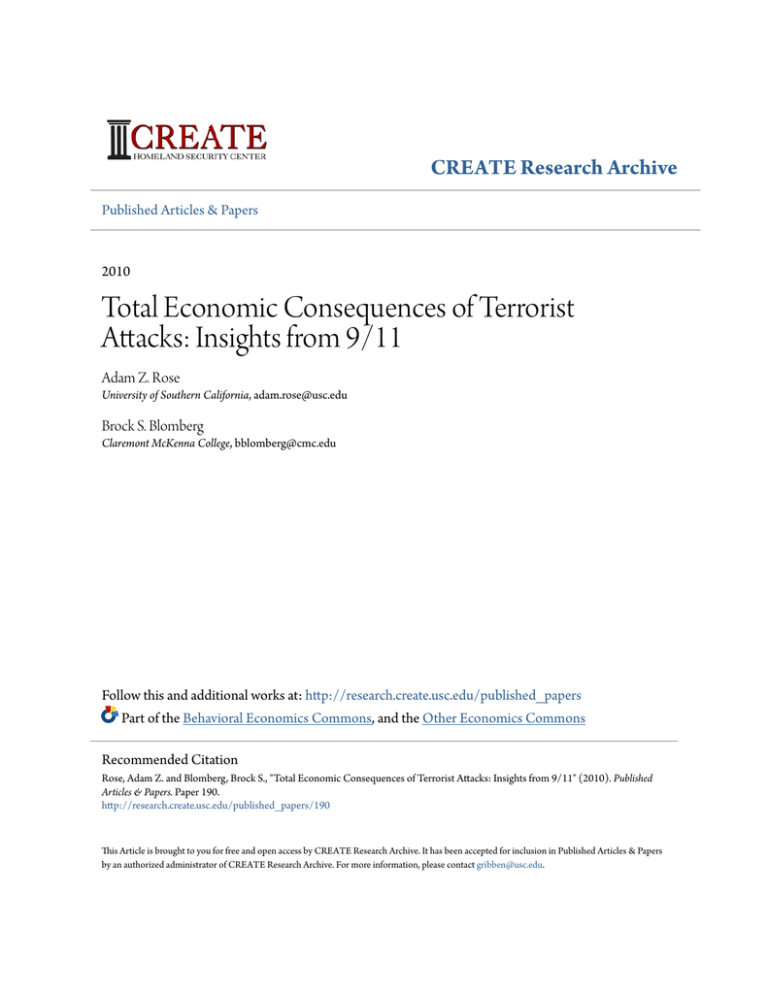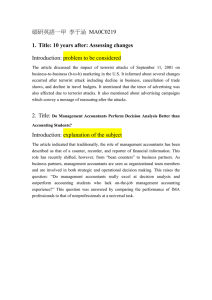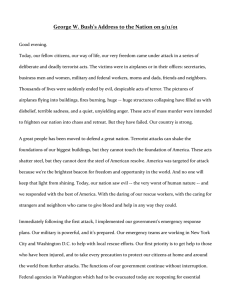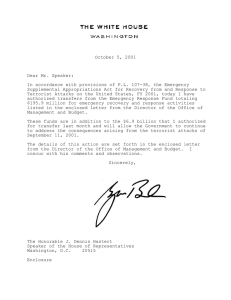
CREATE Research Archive
Published Articles & Papers
2010
Total Economic Consequences of Terrorist
Attacks: Insights from 9/11
Adam Z. Rose
University of Southern California, adam.rose@usc.edu
Brock S. Blomberg
Claremont McKenna College, bblomberg@cmc.edu
Follow this and additional works at: http://research.create.usc.edu/published_papers
Part of the Behavioral Economics Commons, and the Other Economics Commons
Recommended Citation
Rose, Adam Z. and Blomberg, Brock S., "Total Economic Consequences of Terrorist Attacks: Insights from 9/11" (2010). Published
Articles & Papers. Paper 190.
http://research.create.usc.edu/published_papers/190
This Article is brought to you for free and open access by CREATE Research Archive. It has been accepted for inclusion in Published Articles & Papers
by an authorized administrator of CREATE Research Archive. For more information, please contact gribben@usc.edu.
Peace Economics, Peace Science and
Public Policy
Volume 16, Issue 1
2010
Article 2
Total Economic Consequences of Terrorist
Attacks: Insights from 9/11
Adam Z. Rose∗
∗
†
S. Brock Blomberg†
University of Southern California, adam.rose@usc.edu
Claremont McKenna College, bblomberg@cmc.edu
c
Copyright 2010
The Berkeley Electronic Press. All rights reserved.
Total Economic Consequences of Terrorist
Attacks: Insights from 9/11∗
Adam Z. Rose and S. Brock Blomberg
Abstract
Osama bin Laden has emphasized his intent to ruin the U.S. economy. This paper addresses
the reason why the September 11 attacks on the World Trade Center fell far short of this goal.
It provides estimates of the various types of economic impacts and the factors that affected their
relative magnitudes. Special attention is devoted to the resilience of the New York Metro and U.S.
economies, how changes in risk perceptions translated into changes in economic behavior, and
the impacts of terrorism on economic growth. The analysis is based on a collaborative research
effort of eight modeling teams through a research process that included: a common scope and set
of basic assumptions and data, and several iterations of comparing and refining simulations and
econometric tests. An important conclusion of this paper is that we, rather than the perpetrators,
are the major determinant of the consequences of a major terrorist attack. After 9/11, our resilience
was high, but so was our fear, both of which had profound effects on the bottom line, though in
opposite directions. Government policy in the form of Federal Reserve action and fiscal policy
reduced the losses significantly. However, subsequent anti-terrorist initiatives at home and abroad
were more costly than the direct damage caused by the attack.
∗
This research was supported by the U.S. Department of Homeland Security. This is a synopsis of
a paper presented at one of the Peace Science Society International sessions at the Allied Social
Science Association Meetings in Atlanta, GA, January 4, 2010. The authors wish to thank other
members of the Terrorist Economic Impact Modeling Forum (see Rose and Blomberg, 2009) for
their contributions. We also appreciate the helpful comments from our discussant at the PSSI
session, Claude Berrebi. The views expressed in this paper are solely those of the authors and do
not necessarily represent those of the organizations with which they are affiliated.
Rose and Blomberg: Total Economic Consequences of Terrorist Attacks: Insights from 9/11
1. Introduction
Recent studies indicate that the make-up of economic consequences of terrorist
attacks differs greatly from ordinary events and even other disasters. This paper
provides an expanded framework for analyzing these distinctions. This includes
an explicit role for resilience, behavioral linkages, remediation, mitigation,
interdiction, and macroeconomic interactions. We illustrate the importance of
including these factors by summarizing the results of recent studies of the
September 11, 2001, terrorist attacks. This decomposition facilitates an evaluation
of policy options that are most likely to lead to cost-effective reductions in future
economic losses from terrorist attacks. An important conclusion of this paper is
that we, rather than the perpetrators, are the major determinant of the
consequences of a terrorist attack. After 9/11, our resilience was high, but so was
our fear, both of which had profound effects on the bottom line, though in
opposite directions. Government policy in the form of Federal Reserve action and
fiscal policy reduced the losses significantly. However, subsequent anti-terrorist
initiatives at home and abroad were more costly than the direct damage caused by
the attack.
2. An Expanded Framework for Economic Consequence Analysis
Rose (2009) recently formulated an expanded framework for estimating
economic consequences of terrorist attacks and natural disasters to account for
several standard and expanded considerations that affect the overall outcome.
Until recently, economic loss estimation focused almost entirely on standard
target-specific (Direct) Economic Impacts and Loss of Life. The major
expansions of the framework are the addition of Resilience and Extended
Linkages, which greatly affect economic consequences. Resilience adjustments
refer to actions that mute the initial shock and that hasten recovery. They have
the effect of lowering direct business interruption, a major category of targetspecific economic impacts. Extended Linkages refer to extreme behavioral
reactions (such as fear of going to work or shopping in a high risk area) or
cascading system failures (mainly through interdependent infrastructure). Direct
Remediation costs can be especially large in the case of biological and
radiological terrorist attacks and should be inserted into the analysis at an early
stage, in part, because they, along with the two more standard features, are subject
to indirect effects (often referred to as multiplier, general equilibrium, or
macroeconomic effects). Mitigation and Interdiction costs can likewise be large
in the form of extensive airport screening and military initiatives. The sum of all
these positive and negative components yields a thorough bottom-line estimate of
total economic consequences.
Published by The Berkeley Electronic Press, 2010
1
Peace Economics, Peace Science and Public Policy, Vol. 16 [2010], Iss. 1, Art. 2
Disaster
Event Scenario
Target Specific
Economic Impacts
Loss of Life
Direct
Remediation
Costs
Resilience Adjustments
Extended
Linkages
Macroeconomic
Impacts
Mitigation
Impacts Total Economic
Impacts
Figure 1. Economic Consequence Analysis Framework
A. Resilience
Resilience refers to the ability of an entity or system to maintain function (e.g.,
continue producing) when shocked (see also Rose, 2007). It is thus aligned with
the fundamental economic problem--efficient allocation of resources, which is
made all the more challenging by a disaster. This aspect is interpreted as static
because it can be attained without repair and reconstruction activities, which
affect not only the current level of economic activity but also its future time path.
Another key feature of static economic resilience is that it is primarily a demandside phenomenon involving users of inputs (customers) rather than producers
(suppliers). It pertains to ways to use resources available as effectively as
possible. This is in contrast to supply-side considerations, which usually require
the repair or reconstruction of critical assets.
A more general definition that incorporates dynamic considerations is the
speed at which an entity or system recovers from a severe shock to achieve a
desired state. This also subsumes the concept of mathematical or system stability
because it implies the system is able to bounce back. This version of resilience is
also more complex because it involves a long-term investment problem associated
with repair and reconstruction.
Ability implies a level of attainment will be achieved. Hence, the
definition is contextual--the level of function has to be compared to the level that
http://www.bepress.com/peps/vol16/iss1/2
DOI: 10.2202/1554-8597.1189
2
Rose and Blomberg: Total Economic Consequences of Terrorist Attacks: Insights from 9/11
would have existed had the ability been absent. This means a reference point or
type of worst case outcome must be established first.1
B. Behavioral Linkages
Behavioral linkages refer to off-site responses to a disaster that manifest
themselves in altered perceptions of risk that have economic consequences.
These impacts, often unique to disasters, are not typically captured in
conventional models and can cause indirect impacts to be orders of magnitude
greater than ordinary multiplier, general equilibrium, or macroeconomic effects.
One key aspect stems from the “social amplification of risk,” where, media
distortion, increased risk aversion, or increased safety tolerances come in to play
(see, e.g., Kasperson et al., 2003; Burns and Slovic, 2010). For example, terrorist
contamination of the water supply of one city may cause operators of water
systems in neighboring cities to shut down until testing has been completed. Even
if this action is not taken, the situation may make households and businesses shy
away from using tap water and thereby incur various additional costs of
substitution or relocation. If a contagious agent is injected into the water system,
this may cause people to avoid contact with others, such as withholding their
children from school or not going to work.
Some forms of terrorism, especially repeated ones, can lead to a general
social malaise that affects the economy, though some cultures (e.g., the UK and
Israel) have been able to attain a new state of "normalcy" and lower level of
economic losses after a time. Others, such as a “dirty bomb” or radionuclide
contamination of the water system, can kill or injure large percentages of a
population, leading to ghost towns that may not recover because of fear of
lingering contamination or stigma (as in the case of the area around the Chernobyl
nuclear power plant).
1
Several studies have found resilience to be sizeable in short-term or limited cases, such as water
and electricity outages following earthquakes (Tierney, 1997; Rose and Liao, 2005) and terrorist
attacks (Rose et al., 2007). Back-up systems, price adjustments, production rescheduling were
found to be major sources of resilience, and relatively inexpensive as well. Flynn (2008) has
emphasized the “empowering” nature of resilience that inspires individuals to rally in the
aftermath of extreme events. This represents a major resource as well and lessens the need for
government actions and expenditures to deal with disasters.
Published by The Berkeley Electronic Press, 2010
3
Peace Economics, Peace Science and Public Policy, Vol. 16 [2010], Iss. 1, Art. 2
3. Economic Impacts of 9/11
A collaborative research effort known as the Terrorism Economic Impact
Modeling Forum (TEIMF) was recently completed to estimate the impacts of the
September 11, 2001, Terrorist Attacks (Rose and Blomberg, 2009). Eight
modeling teams contributed to the Project in an iterative research process that
included: agreeing to a scope and set of basic assumptions and data, and then
running, comparing and refining simulations and econometric tests. Participants
also offered suggestions for improving each others’ methodologies.
A. Overall Results
The range of estimates of the impacts of the September 11, 2001, Terrorist
Attacks is rather small, suggesting a certain degree of precision in these findings,
with the median being approximately $50 to $100 billion at the national level (see
Table 1). The low estimate is approximately $35 billion dollars and the high
estimate is approximately $109 billion. The one outlier is the study by Gordon et
al., which admittedly was unable to distinguish the impacts of 9/11 from the ongoing recession.2
B. Decomposition: Resilience and Behavioral Linkages
Here we focus on one of the papers in which the analytical framework was
applied to the estimation of the economic consequences of the 9/11 attacks on the
World Trade Center (WTC) using a computable general equilibrium model (Rose
et al., 2009). This was a “bottom-up” analysis that more readily lends itself to a
decomposition of the main results.
2
Early estimates by Looney (2002) put the cost of lost physical assets to be “$14 billion for
private businesses, $1.5 billion for state and local government enterprises and $0.7 billion for
federal enterprises. … The implied projected cumulative loss in national income through the end
of 2003 amounted to 5 percentage points of annual GDP, or half a trillion dollars.” Others have
made more conservative estimates. Bernasek (2002) estimates business costs associated with the
attack to be as much as $151 billion. The International Monetary Fund (2001) found that “the loss
of output from all these sources could be as much as ¾ percent of GDP,” or approximately $75
billion in 2001 dollars.
http://www.bepress.com/peps/vol16/iss1/2
DOI: 10.2202/1554-8597.1189
4
Rose and Blomberg: Total Economic Consequences of Terrorist Attacks: Insights from 9/11
Table 1. Economic Impacts on the U.S. Economy
of the September 11 Terrorist Attacks
(in billion 2006$)
Gross Domestic Product (unless otherwise noted)
Team/
Time Period
Upper Bounda
Level
%
Rose et al.
2001-02
(value added)
Werling &
Horst
2001-02
Park et al.
2001-02
Blomberg &
Hess
2001 only
Treyz & Leung
2006-2020
Roberts
2001 only
$246
c
2.1
Average
Level
%
Lower Boundb
Level
%
Shocks
only
$109
1.0
$94
0.8
$37
d
0.3
$549
4.7
$275
2.4
$0
0.0
$122
1.1
$58
0.5
$23
0.2
$18
0.2
$56
0.5
Scope
Shocks &
response
Shocks &
recession
Shocks &
response
Shocks
only
Shocks &
response
a
Typically involves assumptions of low levels of resilience.
Typically involves assumptions of high levels of resilience.
c
Ascribes all national and NYC Metro Region losses to 9/11, and none to the national recession.
d
Ascribes no national and NYC Metro Region losses to 9/11, and all to the national recession.
b
The analysis indicated that potential direct business interruption (BI)
losses were on the order of $43 billion in GDP, but that, because 95% of the more
than 1,100 businesses located in the WTC area were able to relocate rather
quickly, the direct BI losses were only $12 billion (as associated with the
"downtime"). Indirect (general equilibrium) BI amounted to $14 billion. Thus,
the direct resilience of the economy with respect to business relocation was 72%
[(43-12)/43].
Published by The Berkeley Electronic Press, 2010
5
Peace Economics, Peace Science and Public Policy, Vol. 16 [2010], Iss. 1, Art. 2
The largest single impact of the event was due to the fear factor
manifesting itself in a reduction in air travel and related tourism for nearly two
years after the event. After adjusting for the pre-existing downturn in airline
travel, this amounted to $50 billion of direct BI and $60 billion of indirect BI.
Thus, extended linkages accounted for more than 80% of the total loss of GDP
due to the event.
4. Other Impacts
Other factors contributing to the impacts are summarized below. Many of the
estimates were generated by "top-down" macroeconomic analyses as part of the
TEIMF Project, as well as from related studies on 9/11.
A. Property Damage and Remediation
Grossi (2009) found that there was $22.7 billion loss to property in and around the
WTC complex as a result of the terrorist attacks. The New York City’s
Comptroller's Office estimate “to replace the buildings, infrastructure and other
amenities" was $22 billion (Wray, 2008). Bram et al. (2009), in a comprehensive
study estimated that the cost of cleaning up the site, replacing the destroyed
World Trade Center buildings, and repairing damaged buildings and infrastructure
would be $22.7 billion.
B. Macroeconomic
The TEIMF study by Blomberg and Hess (2009) used a method that compared the
impact of terrorist attacks at different points in time in different regions of the
world relative to those times and places at peace to estimate the economic cost of
September 11. They estimated the short-term effects using panel regression
techniques and then conducted a series of robustness checks using VARs, quantile
regressions, and welfare simulations. Using a panel regression they first
estimated the impact of the September 11 attacks to be approximately a 0.50
percentage point decrease in GDP growth, or $60 billion (2006 dollars). The
estimate is robust across VARs, quantile regressions or welfare simulations.
The baseline OLS results include contemporaneous terrorism and lagged
terrorism, lagged GDP, lagged investment share, time and country fixed effects.
These results show that the impact of 9/11 on growth is significant with
approximately a negative 0.5 percentage point impact on GDP per capita growth.
Alternative specifications were considered with little to no difference in the
qualitative results.
http://www.bepress.com/peps/vol16/iss1/2
DOI: 10.2202/1554-8597.1189
6
Rose and Blomberg: Total Economic Consequences of Terrorist Attacks: Insights from 9/11
Because the macroeconomic impact of terrorism may be different on 9/11
than the average impact, they used a quanitile regression technique to estimate the
impact on different parts of the distribution. Using absolute deviations at the 70th
fractile, the impact estimate is a negative 0.44 percentage point impact on GDP
per capita, nearly identical to the OLS estimate.
A structural VAR model was used to estimate the residual impacts for
output, terrorism, external conflict and internal conflict. The impact using the
VAR is also quite similar to the OLS and quanitile estimation, negative 0.48
percentage point impact on GDP per capita. In dollar terms, both the quantile
regression and VAR estimates show that the impact of 9/11 is approximately a
loss of $60 billion to the United States.
Blomberg and Hess (2009) also estimated the impact of terrorism on lost
welfare by tranforming utility into lost GDP growth. They assumed a discount
rate of 8 percent and constant relative risk aversion of 2, which are standard in the
literature. The general qualitative results are not sensitive to slight deviations in
these parameters. In each of these cases, the entire reduction due to the
September 11 attacks is approximately $80 billion.3
C. Monetary and Fiscal Policy
There are significant challenges in distilling the impact of the attacks on
September 11 from other negative factors, as the Year 2001 was marked with
corporate scandals and the headwinds of a recession. There were also monetary
policy adjustments demonstrated by the increase in the funds rate to 6.25 percent
in December 2000.
The empirical exercise is further complicated by expansionary monetary
and fiscal policies that followed shortly after 9/11. This was seen in the reversal
of Federal Reserve policy as the federal funds rate was reduced to its lowest point
ever (at the time), or 1 percent through June 2003, and the fiscal expansion
demonstrated by the Bush tax cuts of 2001-3. The Federal Reserve emphasized
3
It is also worthwhile to note that these analyses are consistent with those of other research teams
participating in the TEIMF Project (Rose and Blomberg, 2009). Werling and Horst (2009)
integrates feature of macroeconometric, input-output, and general equilibrium models, which
allow for full industrial detail and a consistent representation of the macroeconomy. They show
that compared to the shocks imposed on the model, the net, six-year effect on overall real GDP is
relatively small--$35 billion, or about 0.3 percent of GDP in 2001. Roberts (2009) makes a
significant departure from other approaches by analyzing how economic forecasters themselves
estimated the economic consequence. Real-time forecast evidence suggests that the short-run
macroeconomic impacts of the 9/11 attack were a reduction in real GDP growth in 2001 of 0.5
percent.
Published by The Berkeley Electronic Press, 2010
7
Peace Economics, Peace Science and Public Policy, Vol. 16 [2010], Iss. 1, Art. 2
its vigilance of the financial sector by interjecting a then unprecedented $100
billion into the banking system in particular because of the disruption of interbank
payments. Lacker (2004) suggests that had the Fed acted in a less aggressive
manner, the stock market might have dropped much more than it did and the crisis
might have expanded to the broader financial system.
D. Mitigation/Interdiction
Scholarly debate about the economic costs of military intervention focuses on
long-term security and rebuilding considerations, human capital and infrastructure
losses, and many other direct and indirect costs of war. Nordhaus (2002)
considered two potential scenarios ranging from a short conflict to a more
prolonged conflict to include expensive postwar reconstruction and occupation.
He finds that the cost to the United States would range from $100 billion to $1.9
trillion over the next decade. Subsequent research has found similar wide-ranging
estimates (see Bilmes and Stiglitz 2008; and Davis et al., 2006).4
Still, two conceptual considerations dominate this aspect of the analysis.
The first is whether mitigation actions should be considered in relation to future
events or the one that stimulates them. We suggest that they are appropriately
considered as a cost of 9/11. The second is the open question of whether the Iraq
War was primarily a reaction to 9/11 or primarily motivated by other objectives.
We pass no judgment on this matter here (cf., Nordhaus, 2002).
5. Policy Lessons
Even though the impacts of the September 11 Terrorist Attacks were relatively
small, they could have been diminished further. We need to maintain and
enhance our resilience, quell our fears, and target government macro policy and
mitigation where it is most effective. The following lessons provide some
guidance for future efforts to reduce the economic consequences of terrorism:
4
Estimating the cost of the war to the citizens of Iraq has received some attention as well (see
IMF, 2003; Foote et al., 2004). Blomberg and Engel (2009) study losses due to increased price
uncertainty in Iraq following the war by investigating the impact on prices during the war and
during the troop surge. For the country as a whole, average price dispersion was 24 percent in the
weeks before the surge, 22 percent during the weeks of the surge, and 23 percent in the weeks
after the surge. These summary statistics suggest that the surge reduced average price dispersion
by about 2 percentage points, from the pre-surge level. They also find that average price
dispersion falls except two Shia regions during the surge and subsequently increases except in
three Sunni regions. This degree of price uncertainty is significantly higher than that found
previously using similar data in Japan, about 12 percent (see Chueng and Fujii, 2008).
http://www.bepress.com/peps/vol16/iss1/2
DOI: 10.2202/1554-8597.1189
8
Rose and Blomberg: Total Economic Consequences of Terrorist Attacks: Insights from 9/11
•
•
•
•
Ordinary markets for goods and services and individual initiative are
major sources of resilience and worked in the aftermath of 9/11.
Individual businesses survived by relocating quickly and individual
consumers made many worthy adjustments.
Financial markets require immediate attention and support.
The
macroeconomy benefited from countervailing monetary and fiscal policy
as well.
Fear translated into negative economic consequences. Efforts need to be
made to improve the accuracy of reporting of events. Governments need
to find ways to communicate the strengths and limitations of their
capabilities to protect it.
Market and government failures need to be corrected to reduce the costs
and improve the effectiveness of mitigation. Government policies should
not undercut private initiative. Government agencies need to work more
effectively together to shore up gaps and avoid duplication.
References
BAKER, M., JR., INC., (2008), "Municipal Water Distribution System Security
Study: Recommendations for Science and Technology Investments,"
Final Report to the U.S. Department of Homeland Security, Washington,
DC.
BERNASEK, A., (2002), "The Friction Economy," Fortune 18 Feb. 2002, 21 Feb.
2002.
BILMES, L., J. STIGLITZ , (2008), The Three Trillion Dollar War: The True Cost of
the Iraq Conflict, New York: W.W. Norton.
BLOMBERG, S. B., R. ENGEL, (2009), "Lines in the Sand: Price Dispersion and the
Economic Impact of a Military Troop Surge." mimeo
BLOMBERG, S. B., G. HESS, (2009), "Estimating the Macroeconomic
Consequence of 9/11," Peace Economics, Peace Science and Public
Policy, vol. 15, n. 2.
Published by The Berkeley Electronic Press, 2010
9
Peace Economics, Peace Science and Public Policy, Vol. 16 [2010], Iss. 1, Art. 2
BLOMBERG, S. B., A. ROSE, (2009), "Editor’s Introduction to the Economic
Impacts of the September 11, 2001 Terrorist Attacks," Peace Economics,
Peace Science and Public Policy, vol. 15, n. 2.
BRAM, J., A. HOUGHWOUT, J. ORR, (2009), "Further Observations on the
Economic Effects on New York City of the Attack on the World Trade
Center," Peace Economics, Peace Science and Public Policy, vol. 15, n. 2.
BURNS, W., P. SLOVIC, (2010), "Public Response to a Terrorist Strike," Risk
Analysis, forthcoming.
CHEUNG, Y. , E. FUJII, (2009), "Deviations from the Law of One Price in Japan,”
CESifo Working Paper Series No. 2275 Available at SSRN:
http://ssrn.com/abstract=1118285.
DAVIS,
S., K. MURPHY, R. TOPEL, (2006),
Containment," NBER Working Paper 12092.
"War
in
Iraq
Versus
FLYNN, S., (2008), "America the Resilient: Defying Terrorism and Mitigating
Natural Disasters," Foreign Affairs, vol. 87, n. 2, p. 2.
FOOTE, C., W. BLOCK, K. CRANE, S. GRAY, (2004), "Economic Policy and
Prospects in Iraq," Journal of Economic Perspectives, vol. 18, n. 3, pp. 4770.
GORDON, P., E. JUN, J. MOORE II, J. PARK, H. W. RICHARDSON, (2009),
"Identifying the Regional Economic Impacts of 9/11," Peace Economics,
Peace Science and Public Policy, vol. 15, n. 2.
GROSSI, P., (2009), "Property Damage and Insured Losses from the 2001 World
Trade Center Attacks," Peace Economics, Peace Science and Public
Policy, vol. 15, n. 2.
INTERNATIONAL MONETARY FUND, (2003), "Iraq: Macroeconomic Assessment,"
October. Available at http://www.imf.org/external/np/oth/102103.pdf
KASPERSON, J. X., R. E. KASPERSON, N. PIDGEON, P. SLOVIC, (2003), “The Social
Amplification of Risk: Assessing Fifteen Years of Research and Theory,”
in N. Pidgeon et al. (eds.), The Social Amplification of Risk.
http://www.bepress.com/peps/vol16/iss1/2
DOI: 10.2202/1554-8597.1189
10
Rose and Blomberg: Total Economic Consequences of Terrorist Attacks: Insights from 9/11
LACKER, J., (2004), "Payment System Disruptions and the Federal Reserve
Following September 11", 2001, Journal of Monetary Economics, vol. 51,
n. 5, pp. 935-65.
LOONEY, R., (2002), "Economic Costs to the United States Stemming from the
9/11 Attacks," Strategic Insights, vol. 6, n. 1.
NORDHAUS, W., (2002), "The Economic Consequences of a War in Iraq," NBER
Working Paper No. 9361.
ROBERTS, B, (2009), "The Macroeconomic Impacts of the 9/11 Attack: Evidence
from Real-Time Forecasting," Peace Economics, Peace Science and
Public Policy, vol. 15, n. 2.
ROSE, A., (2007), "Economic Resilience to Natural and Man-Made Disasters:
Multidisciplinary Origins and Contextual Dimensions," Environmental
Hazards: Human and Social Dimensions, vol. 7, n. 4, pp. 383-98.
ROSE, A., (2009), "A Framework for Analyzing the Total Economic Impacts of
Terrorist Attacks and Natural Disasters," Journal of Homeland Security
and Emergency Management vol. 6, n.1, pp. 1-26.
ROSE, A., S. B. BLOMBERG, (2009), "The Economic Impacts of the September 11,
2001, Terrorist Attacks," Peace Economics, Peace Science and Public
Policy, vol. 15, n. 2.
ROSE, A., S. LIAO, (2005), "Modeling Resilience to Disasters: Computable
General Equilibrium Analysis of a Water Service Disruption," Journal of
Regional Science, vol. 45, n. 1, pp. 75-112
ROSE, A., G. OLADOSU, S. LIAO, (2007), "Regional Economic Impacts of a
Terrorist Attack on the Water System of Los Angeles: A Computable
General Disequilibrium Analysis," in H. Richardson, P. Gordon, and J.
Moore, II (eds.), Economic Costs and Consequences of a Terrorist Attack,
Cheltenham, UK: Edward Elgar.
ROSE, A., G. OLADOSU, B. LEE, G. ASAY BEELER, (2009), "The Economic Impacts
of the 2001 Terrorist Attacks on the World Trade Center: A Computable
General Equilibrium Analysis," Peace Economics, Peace Science and
Public Policy, vol. 15, n. 2.
Published by The Berkeley Electronic Press, 2010
11
Peace Economics, Peace Science and Public Policy, Vol. 16 [2010], Iss. 1, Art. 2
TIERNEY, K., (1997), "Impacts of Recent Disasters on Businesses: The 1993
Midwest Floods and the 1994 Northridge Earthquake," in B. Jones (ed.),
Economic Consequences of Earthquakes: Preparing for the Unexpected,
Buffalo, NY: National Center for Earthquake Engineering Research.
WRAY, R. (2002), "New York Counts Cost of 9/11 Comptroller Estimates City's
Overall Bill at up to $95bn," The Guardian, Thursday 5, September 2002.
http://www.bepress.com/peps/vol16/iss1/2
DOI: 10.2202/1554-8597.1189
12







